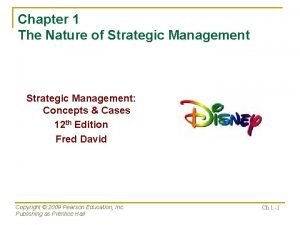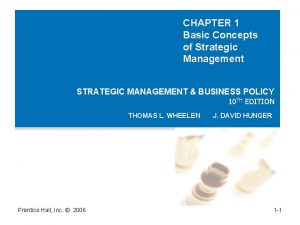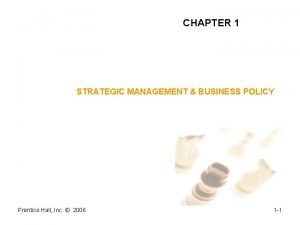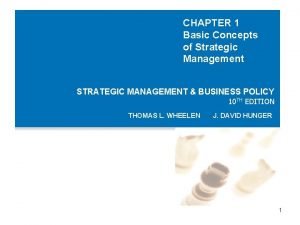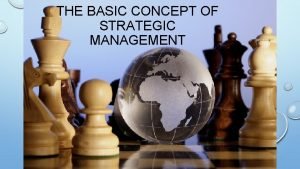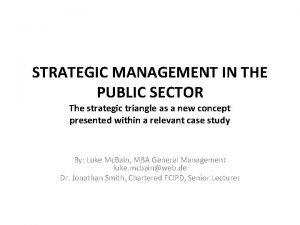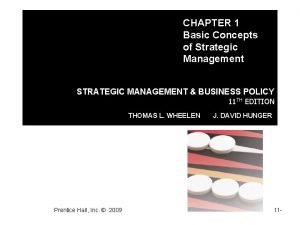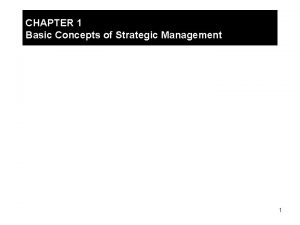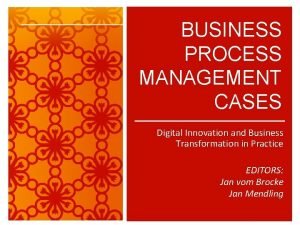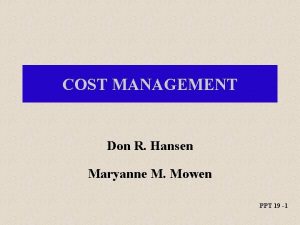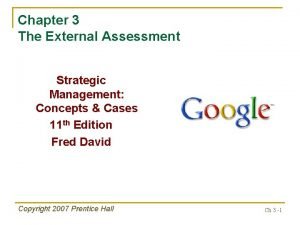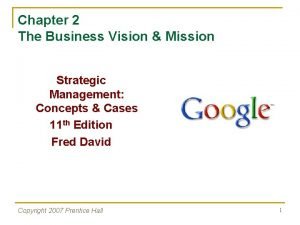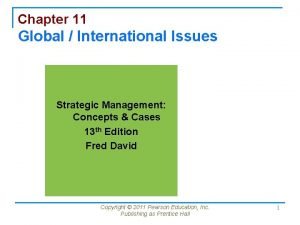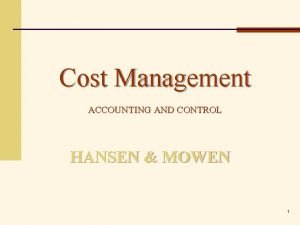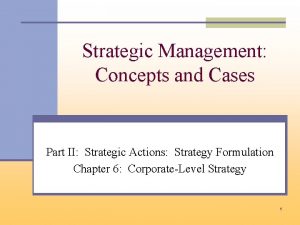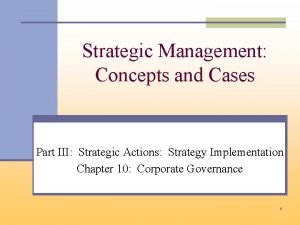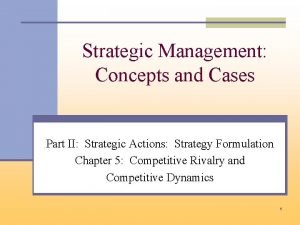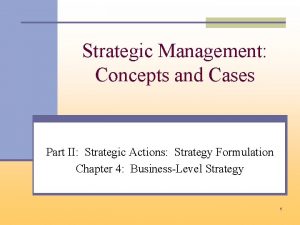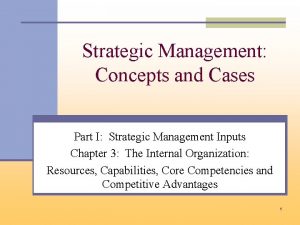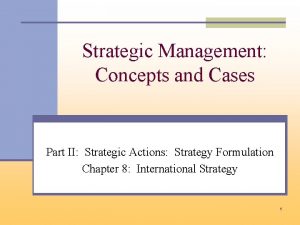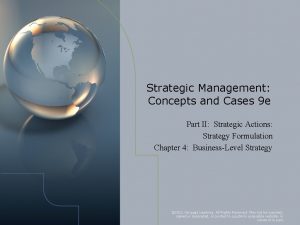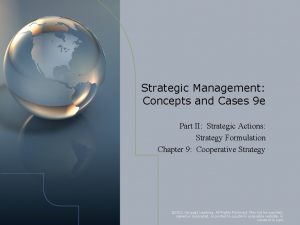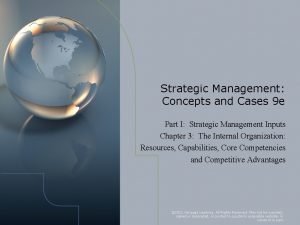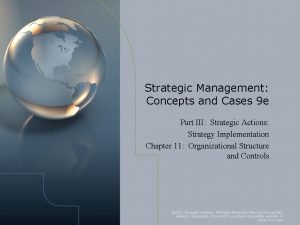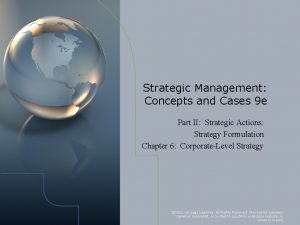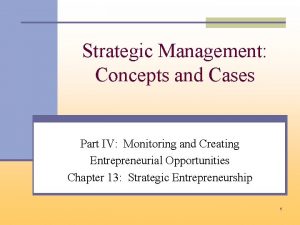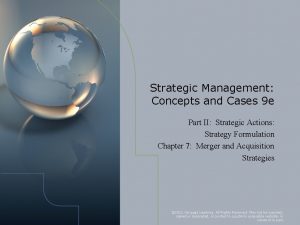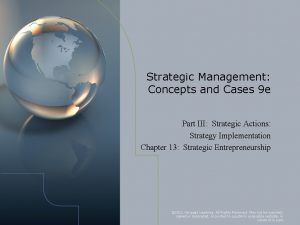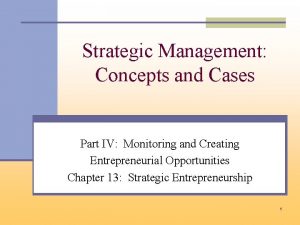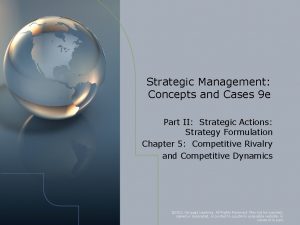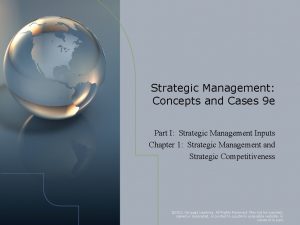Strategic Management Concepts and Cases 9 e Part





































- Slides: 37

Strategic Management: Concepts and Cases 9 e Part II: Strategic Actions: Strategy Formulation Chapter 8: International Strategy © 2011 Cengage Learning. All Rights Reserved. May not be scanned, copied or duplicated, or posted to a publicly accessible website, in whole or in part.

The Strategic Management Process © 2011 Cengage Learning. All Rights Reserved. May not be scanned, copied or duplicated, or posted to a publicly accessible website, in whole or in part.

Chapter 8: International Strategy (IS) • Overview: Eight content areas – Traditional vs. emerging motives – Four major benefits of International Strategies (IS) – Four factors as basis for international business strategy – Three international corporate-level strategies – Environmental trends affecting IS – Five alternative modes for entering international markets – Effects of international diversification on returns & innovation – Two major risks of international diversification © 2011 Cengage Learning. All Rights Reserved. May not be scanned, copied or duplicated, or posted to a publicly accessible website, in whole or in part.

Foreign Firms Entering China and Chinese Firms Going Global • Chinese market is large and lucrative – Foreign firms manufacture in China for cost savings – Auto industry manufacturing examples: • GM venture with Shanghai Automotive Industry Corporation • Volkswagen venture also with Shanghai Automotive • GM venture with Liuzhous Wuling Motors Co. – Auto industry market area examples: • Porsche expects 2009 sales in China to exceed sales in U. S. • Google partnership with music labels to compete with Baidu • Chinese firms competing abroad – Huawei Technologies Co. Ltd. (telecom) – ZTE (wireless networks) © 2011 Cengage Learning. All Rights Reserved. May not be scanned, copied or duplicated, or posted to a publicly accessible website, in whole or in part.

Introduction • Many firms choose direct investment in assets over indirect investment – Provides better protection for assets © 2011 Cengage Learning. All Rights Reserved. May not be scanned, copied or duplicated, or posted to a publicly accessible website, in whole or in part.

Opportunities and Outcomes of International Strategy © 2011 Cengage Learning. All Rights Reserved. May not be scanned, copied or duplicated, or posted to a publicly accessible website, in whole or in part.

Chapter 8: International Strategy (IS) • Overview: Eight content areas – Traditional vs. emerging motives – Four major benefits of International Strategies (IS) – Four factors as basis for international business strategy – Three international corporate-level strategies – Environmental trends affecting IS – Five alternative modes for entering international markets – Effects of international diversification on returns & innovation – Two major risks of international diversification © 2011 Cengage Learning. All Rights Reserved. May not be scanned, copied or duplicated, or posted to a publicly accessible website, in whole or in part.

Identifying International Opportunities: Incentives to Use an International Strategy (IS) • International Strategy (IS): firm sells its goods or services outside the domestic market • Reasons for an IS – International markets yield potential new opportunities – International diversification: innovation occurs in homecountry market, especially in an advanced economy, and demand for product develops in other countries, so exports provided by domestic organization – Multinational strategy: Secure need resources – Other motives exist (i. e. , pressure for global integration, borderless demand for globally branded products) © 2011 Cengage Learning. All Rights Reserved. May not be scanned, copied or duplicated, or posted to a publicly accessible website, in whole or in part.

Identifying International Opportunities: Incentives to Use an International Strategy (IS) (Cont’d) • Four primary reasons – 1. Increased market size • Domestic market may lack the size to support efficient scale manufacturing facilities – 2. Return on Investment (ROI) • Large investment projects may require global markets to justify the capital outlays • Weak patent protection in some countries implies that firms should expand overseas rapidly in order to preempt imitators © 2011 Cengage Learning. All Rights Reserved. May not be scanned, copied or duplicated, or posted to a publicly accessible website, in whole or in part.

Identifying International Opportunities: Incentives to Use an International Strategy (IS) (Cont’d) • Four primary reasons (Cont’d) – 3. Economies of Scale and Learning • Expanding size or scope of markets helps to achieve economies of scale in manufacturing as well as marketing, R&D, or distribution • Costs are spread over a larger sales base • Profit per unit is increased – 4. Location advantages: Low cost markets may… • … aid in developing competitive advantage • … achieve better access to critical resources: – i. e. , raw materials, lower cost labor, key customers, energy © 2011 Cengage Learning. All Rights Reserved. May not be scanned, copied or duplicated, or posted to a publicly accessible website, in whole or in part.

Chapter 8: International Strategy (IS) • Overview: Eight content areas – Traditional vs. emerging motives – Four major benefits of International Strategies (IS) – Four factors as basis for international business strategy – Three international corporate-level strategies – Environmental trends affecting IS – Five alternative modes for entering international markets – Effects of international diversification on returns & innovation – Two major risks of international diversification © 2011 Cengage Learning. All Rights Reserved. May not be scanned, copied or duplicated, or posted to a publicly accessible website, in whole or in part.

International Strategies (IS) • Firms choose one or both of two basic type of IS: Business level and/or corporate level • International business-level strategy – Follows generic strategies of cost-leadership, differentiation, focused or broad • International corporate-level strategy (N=3) – Home country usually most important source of competitive advantage • Resources and capabilities frequently allow firm to pursue markets in other countries • The determinants of national advantage includes 4 factors © 2011 Cengage Learning. All Rights Reserved. May not be scanned, copied or duplicated, or posted to a publicly accessible website, in whole or in part.

Determinants of National Advantage © 2011 Cengage Learning. All Rights Reserved. May not be scanned, copied or duplicated, or posted to a publicly accessible website, in whole or in part.

International Corporate-Level Strategies © 2011 Cengage Learning. All Rights Reserved. May not be scanned, copied or duplicated, or posted to a publicly accessible website, in whole or in part.

International Strategies (IS) (Cont’d) • International corporate-level strategies • 1. Multidomestic (Cont’d) – Decentralized strategic & operating decisions by strategic business-unit (SBU) in each country allows units to tailor products to local markets – Focuses on variations of competition within each country – Customized products to meet local customers’ specific needs and preferences – Takes steps to isolate the firm from global competitive forces • Establish protected market positions • Compete in industry segments most affected by differences among local countries – Deals with uncertainty from differences across markets © 2011 Cengage Learning. All Rights Reserved. May not be scanned, copied or duplicated, or posted to a publicly accessible website, in whole or in part.

International Strategies (IS) (Cont’d) • 2. Global – Firm offers standardized products across country markets, with the competitive strategy being dictated by the home office – Emphasizes economies of scale – Facilitated by improved global reporting standards (i. e. , accounting and financial) – Strategic & operating decisions centralized at home office © 2011 Cengage Learning. All Rights Reserved. May not be scanned, copied or duplicated, or posted to a publicly accessible website, in whole or in part.

International Strategies (IS) • 2. Global (Cont’d) – Involves interdependent SBUs operating in each country – Home office attempts to achieve integration across SBUs, adding management complexity – Produces lower risk – Is less responsive to local market opportunities – Offers less effective learning processes (pressure to conform and standardize) © 2011 Cengage Learning. All Rights Reserved. May not be scanned, copied or duplicated, or posted to a publicly accessible website, in whole or in part.

International Strategies (IS) (Cont’d) • 3. Transnational – Firm seeks to achieve both global efficiency and local responsiveness – these are competing goals! – Requires both global coordination and local flexibility with this strategy/structure combination • Flexible Coordination: Building a shared vision and individual commitment through an integrated network – Challenging, but becoming increasingly necessary to compete in international markets – Growing number of global competitors heightens need to keep costs down while greater information flow and desire for specialized products pressures firms to differentiate and even customize products – nonetheless, – Increasingly used as a strategy © 2011 Cengage Learning. All Rights Reserved. May not be scanned, copied or duplicated, or posted to a publicly accessible website, in whole or in part.

Chapter 8: International Strategy (IS) • Overview: Eight content areas – Traditional vs. emerging motives – Four major benefits of International Strategies (IS) – Four factors as basis for international business strategy – Three international corporate-level strategies – Environmental trends affecting IS – Five alternative modes for entering international markets – Effects of international diversification on returns & innovation – Two major risks of international diversification © 2011 Cengage Learning. All Rights Reserved. May not be scanned, copied or duplicated, or posted to a publicly accessible website, in whole or in part.

Environmental Trends • Transnational strategy hard to implement • Two new trends • 1. Liability of foreignness – Increased after terrorists’ attacks and Iraq War – Global strategies not as prevalent today, still difficult to implement even with Internet-based strategies – Regional focus allows firms to marshal resources to compete effectively in regional markets • 2. Regionalization – Focus to a particular region of the world • Increases understanding of market • Achieve some economies • Trade agreements (i. e. , EU, OAS, NAFTA) promote flow of trade across country boundaries with their respective regions © 2011 Cengage Learning. All Rights Reserved. May not be scanned, copied or duplicated, or posted to a publicly accessible website, in whole or in part.

Chapter 8: International Strategy (IS) • Overview: Eight content areas – Traditional vs. emerging motives – Four major benefits of International Strategies (IS) – Four factors as basis for international business strategy – Three international corporate-level strategies – Environmental trends affecting IS – Five alternative modes for entering international markets – Effects of international diversification on returns & innovation – Two major risks of international diversification © 2011 Cengage Learning. All Rights Reserved. May not be scanned, copied or duplicated, or posted to a publicly accessible website, in whole or in part.

International Entry Modes • Follows the selection of an IS • Five main entry modes • 1. Exporting • 2. Licensing • 3. Strategic Alliances • 4. Acquisitions • 5. New Wholly-Owned Subsidiary © 2011 Cengage Learning. All Rights Reserved. May not be scanned, copied or duplicated, or posted to a publicly accessible website, in whole or in part.

International Entry Modes (Cont’d) • 1. Exporting – Involves low expense to establish operations in host country – Often involves contractual agreements – Involves high transportation costs – May have some tariffs imposed – Offers low control over marketing and distribution © 2011 Cengage Learning. All Rights Reserved. May not be scanned, copied or duplicated, or posted to a publicly accessible website, in whole or in part.

International Entry Modes (Cont’d) • 2. Licensing – Involves low cost to expand internationally – Allows licensee to absorb risks – Has low control over manufacturing and marketing – Offers lower potential returns (shared with licensee) – Involves risk of licensee imitating technology and product for own use – May have inflexible ownership arrangement © 2011 Cengage Learning. All Rights Reserved. May not be scanned, copied or duplicated, or posted to a publicly accessible website, in whole or in part.

International Entry Modes (Cont’d) • 3. Strategic Alliances – Involve shared risks and resources – Facilitate development of core competencies – Involve fewer resources and costs required for entry – May involve possible incompatibility, conflict, or lack of trust with partner – Are difficult to manage © 2011 Cengage Learning. All Rights Reserved. May not be scanned, copied or duplicated, or posted to a publicly accessible website, in whole or in part.

International Entry Modes (Cont’d) • 4. Acquisitions – Allow for quick access to market – Involve possible integration difficulties – Are costly – Have complex negotiations and transaction requirements © 2011 Cengage Learning. All Rights Reserved. May not be scanned, copied or duplicated, or posted to a publicly accessible website, in whole or in part.

International Entry Modes (Cont’d) • 5. New Wholly-Owned Subsidiary – Is costly – Involves complex processes – Allows for maximum control – Has the highest potential returns – Carries high risk – Greenfield venture: Establish entirely new subsidiary © 2011 Cengage Learning. All Rights Reserved. May not be scanned, copied or duplicated, or posted to a publicly accessible website, in whole or in part.

International Entry Modes (Cont’d) • Dynamics of Mode of Entry: Use the best suited to the situation at hand; affected by several factors – Export, licensing and strategic alliance: good tactics for early market development – Strategic alliance: used in more uncertain situations – Wholly-owned subsidiary may be preferred if • IP rights in emerging economy not well protected • Number of firms in industry is growing fast • Need for global integration is high – Acquisitions or greenfield ventures: secure a stronger presence in international markets © 2011 Cengage Learning. All Rights Reserved. May not be scanned, copied or duplicated, or posted to a publicly accessible website, in whole or in part.

Chapter 8: International Strategy (IS) • Overview: Eight content areas – Traditional vs. emerging motives – Four major benefits of International Strategies (IS) – Four factors as basis for international business strategy – Three international corporate-level strategies – Environmental trends affecting IS – Five alternative modes for entering international markets – Effects of international diversification on returns & innovation – Two major risks of international diversification © 2011 Cengage Learning. All Rights Reserved. May not be scanned, copied or duplicated, or posted to a publicly accessible website, in whole or in part.

Strategic Competitive Outcomes • International diversification: firm expands sales of its goods or services across the borders of global regions and countries into different geographic locations or markets • Implementation follows selection of international strategy and mode of entry • 1. International diversification and returns • 2. International diversification and innovation • 3. Complexity of managing multinational firms © 2011 Cengage Learning. All Rights Reserved. May not be scanned, copied or duplicated, or posted to a publicly accessible website, in whole or in part.

Strategic Competitive Outcomes (Cont’d) • 1. International diversification and returns – As international diversification increases, firms’ returns initially decrease, but then increase quickly as the firm learns to manage international expansion • 2. International diversification and innovation – Exposure to new products and markets – Opportunity to integrate new knowledge into operations – Generation of resources to sustain innovation efforts © 2011 Cengage Learning. All Rights Reserved. May not be scanned, copied or duplicated, or posted to a publicly accessible website, in whole or in part.

Strategic Competitive Outcomes (Cont’d) • 3. Complexity of managing multinational firms – Geographic dispersion – Costs of coordination – Logistical costs – Trade barriers – Cultural diversity – Host government © 2011 Cengage Learning. All Rights Reserved. May not be scanned, copied or duplicated, or posted to a publicly accessible website, in whole or in part.

Chapter 8: International Strategy (IS) • Overview: Eight content areas – Traditional vs. emerging motives – Four major benefits of International Strategies (IS) – Four factors as basis for international business strategy – Three international corporate-level strategies – Environmental trends affecting IS – Five alternative modes for entering international markets – Effects of international diversification on returns & innovation – Two major risks of international diversification © 2011 Cengage Learning. All Rights Reserved. May not be scanned, copied or duplicated, or posted to a publicly accessible website, in whole or in part.

Risks in International Environment • Two major risks – 1. Political – 2. Economic • Limits to international expansions: management problems © 2011 Cengage Learning. All Rights Reserved. May not be scanned, copied or duplicated, or posted to a publicly accessible website, in whole or in part.

Risk in the International Environment © 2011 Cengage Learning. All Rights Reserved. May not be scanned, copied or duplicated, or posted to a publicly accessible website, in whole or in part.

Risks in International Environment (Cont’d) • 1. Political risks – Government instability – Conflict or war – Government regulations – Conflicting and diverse legal authorities – Potential nationalization of private assets – Government corruption – Changes in government policies © 2011 Cengage Learning. All Rights Reserved. May not be scanned, copied or duplicated, or posted to a publicly accessible website, in whole or in part.

Risks in International Environment (Cont’d) • 2. Economic risks – Differences and fluctuations in currency values – Investment losses due to political risks • Limits to international expansions: management problems – Geographic dispersion – Trade barriers – Logistical costs – Cultural diversity – Other differences by country – Relationship between organization and host country © 2011 Cengage Learning. All Rights Reserved. May not be scanned, copied or duplicated, or posted to a publicly accessible website, in whole or in part.
 Criminal cases vs civil cases
Criminal cases vs civil cases Industrial organization model of above average returns
Industrial organization model of above average returns Strategy analysis and choice largely involves making
Strategy analysis and choice largely involves making According to greenley strategic management
According to greenley strategic management Basic concepts of strategic management
Basic concepts of strategic management Basic concept of strategic management
Basic concept of strategic management Basic concepts of strategic management
Basic concepts of strategic management Basic concept of strategic management
Basic concept of strategic management Strategic management in public sector
Strategic management in public sector Why is it not advisable to pursue many strategies at once
Why is it not advisable to pursue many strategies at once Strategic management decision making process
Strategic management decision making process Basic concept of strategic management
Basic concept of strategic management Multiplying special cases quiz part 2
Multiplying special cases quiz part 2 Strategic substitutes example
Strategic substitutes example Part one—analyzing accounting concepts and procedures
Part one—analyzing accounting concepts and procedures Environmental management: readings and cases
Environmental management: readings and cases Haley strategic family therapy
Haley strategic family therapy Strategic fit vs strategic intent
Strategic fit vs strategic intent Business process management cases
Business process management cases Puppies pigs and people
Puppies pigs and people Part whole model subtraction
Part whole model subtraction Unit ratio definition
Unit ratio definition Part part whole
Part part whole Technical description
Technical description Bar parts and equipment layout
Bar parts and equipment layout The phase of the moon you see depends on ______.
The phase of the moon you see depends on ______. Part to part variation
Part to part variation The managerial process of crafting and executing strategy
The managerial process of crafting and executing strategy Social responsibility and ethics in strategic management
Social responsibility and ethics in strategic management Strategic cost management hansen and mowen
Strategic cost management hansen and mowen External assessment in strategic management
External assessment in strategic management Social responsibility and ethics in strategic management
Social responsibility and ethics in strategic management Mission and vision of strategic management
Mission and vision of strategic management Global and international issues in strategic management
Global and international issues in strategic management Visionary leadership and strategic management
Visionary leadership and strategic management Scope of strategic financial planning
Scope of strategic financial planning Strategic retail management
Strategic retail management Strategic cost management hansen and mowen
Strategic cost management hansen and mowen



